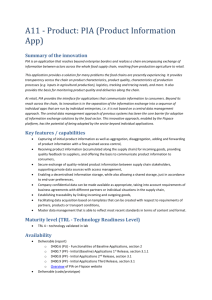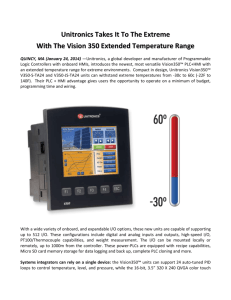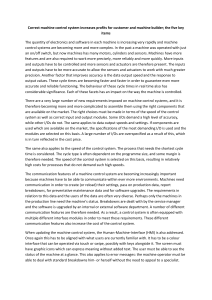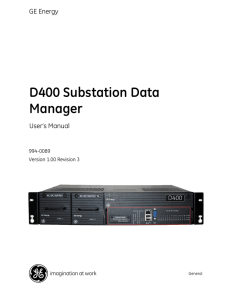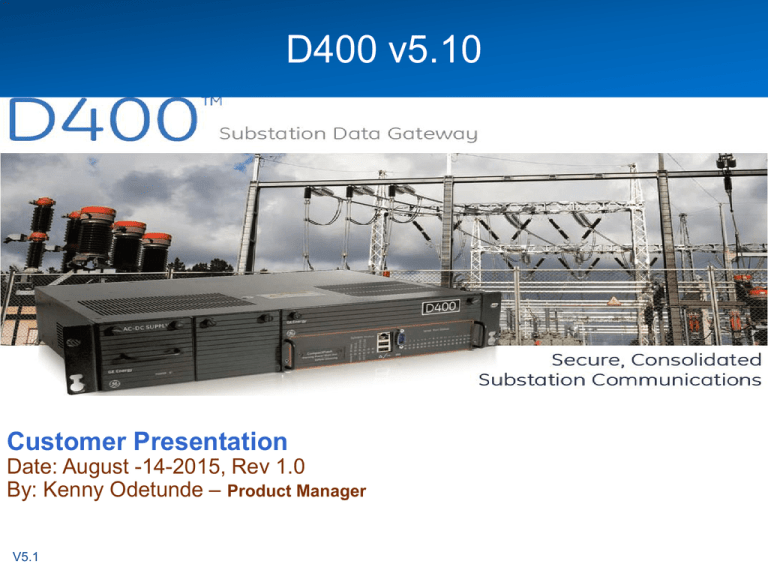
D400 v5.10
Customer Presentation
Date: August -14-2015, Rev 1.0
By: Kenny Odetunde – Product Manager
V5.1
Content
• Overview of the D400
• D400 v5.10 Features/Applications
• Voice of Customers
• Market Activation
• Appendix
D400 Overview and Substation Automation
Substation Automation Products – Intro
Why Substation Automation?
D400 Applications
Introduction - Substation Automation Products
Executive Summary
Advanced Automation - Gateway
Price Range
(kUSD)
D400
D20MX
D20
NERC CIP +
DNP3
iBo
x
IEC 61850-type applications
Embedded HMI
Advanced Automation
Parallel Redundancy Protocol
Automatic Record Retrieval
NERC-CIP
D25
Simple to Advance Applications
Traditional Automation DNP3 & Legacy protocols
- RTUs
GE’s Substation Automation
Products
Simple Applications | Traditional Automation
Modern Platform with Advanced Automation applications
Advanced Applications
61850-type Applications - Gateway
Why
Substation
Automation?
Why
Substation
Automation?
• Optimized Grid Operation
• Integration of Multi vendor IEDs
• Distributed Control
• Enhanced Maintenance Planning
• Safety
• Programmable logic [IEC 61131 ]
• Control lockout
• System Planning
• Sequence of Events
• Analog Data Trending
• Effective non operational data management
• Reliability
• Real time monitoring and control of critical infrastructure
• Secure Access
D400 Applications
Advanced Gateway
Substation Data collection, concentration
and visualization
Advanced Automation
Automate substation procedures using IEC
61131 compliant tools
IEC 61850
Proven IEC 61850 solutions
Fault Record Retrieval, Data
Logging & Analog Report
Generation
Extract, trend and report valuable data
[digital fault records, event files, analog
records]
Secure Remote Access
Securely access substation device locally and
remotely
Parallel Redundancy Support
RTU Capabilities
Interface to proven technology of D20
Series of I/O modules
Advanced Gateway
Substation rated hardware platform
A secure, substation-hardened gateway that collects metering, status, event, and fault report data from
serial or LAN based Intelligent substation devices. It summarize these data and makes them available
locally/remotely through a standard secure web browser (HTTPS). v3.2
Redundant Power supply option for enhanced reliability applications
Substation rated hardware platform
Expandable modular platform
Simplified maintenance and expansion: hot swappable communication modules
D400 D.20TMRIO Distributed IO Controller
MDS WiYZTM
Front Panel
Back Panel
Ethernet Ports
2 x 10/100 Base T
RS 232 Port
Maintenance
port
Expanded RTU capabilities through compatibility with GE D20 series of I/O modules
Recap on D400 v5.01
D400 v3.2 + D400 v4.1
D400 v5.01
Quality Focused
Improved quality to ensure robustness, increased reliability and availability
Over 400+ improvements made
Hybrid firmware model
Hybrid functionalities from D400 v3.2 and D400 v4.1 firmware
User ability to select system redundancy mode as : Hot-standby, Warm-standby or Standalone
modes of operation
D400 v5.10 Features/Applications
Remote Syslog
D400 ARRM Add-on features
HMI Enhancements
Custom Routing
Remote Observer’s Access Change
Auto-Login/Log-out
D400 v5.10 - What’s new?
•
Rsyslog support for archiving remote logs
•
Add-on features for ARRM (Advanced Record Retrieval Manager)
•
D400 HMI enhancements:
•
JRE Update 8 support
•
Redirection of Standby D400’s Local HMI to Active D400
•
User specific, customizable home screens in D400 HMI
•
Disable Remote HMI Non Observer Privileges
•
Auto login/ logout support in Remote HMI
•
Custom routing support
•
Application specific enhancements:
•
MODBUS DCA, Operator Notes, Serial Printer, Calculator, DNPDPA
Differentiated Value Proposition
1.
Rsyslog:
•
2.
ARRM add-on features:
•
3.
All authentication and accounting information logs at one place
Retrieval of files incase of no events and IED connection status info to enterprise systems
D400 Local HMI enhancements:
•
Flexibility & Ease of use
D20 Upgrade options
Rsyslog for archiving remote logs
Rsyslog features in D400
Overview
•
•
•
•
•
Log retrieval in TCP and UDP
Configurable port numbers
Subnet/IP binding
Conforms to RFC 5424
Also interoperable with RFC 3164 based
devices
D20 Upgrade options
D400 ARRM Add On Features
ARRM – Add on Features
D20 Upgrade options
Overview
D20MX Solution
Connection Polling
• Support for Connection Poll based file retrieval
• New configuration parameters added
D400 Gateway name
Connection Polling Interval (station and device)
Include In Connection Polling
Overwrite storage option in file set template
• Enable/disable connection polling at runtime
Connection Status
• IED connection status info file
<
=
<
=
D20 Upgrade options
Custom Routing
Custom Routing
D20 Upgrade options
<
=
Configure D400 to report data to multiple master stations located in different
networks from D400 through any of the available network interfaces/VLANs
Custom Routing
D20 Upgrade options
<
=
Configuration
Step 2 : Add custom route
Step 1 :
• Launch D400cfg
• Select Configure Network Interfaces
• Custom Routing
Step 3 : Display the added custom
routes
D20 Upgrade options
<
=
D400 HMI Enhancements
<
=
Standby Local HMI to point to Active D400
D20 Upgrade options
Use Cases
Without this feature
D400_B
D400_A
Standby D400 Data
Active D400 Data
Standby D400
Active D400
With this feature
D400_B
D400_A
Active D400 Data
Active D400 Data
Standby D400
Active D400
Direct connection
Over Network
Standby Local HMI to point to Active D400
Use Cases 2
To any of the D400s
D400_B
D400_A
Standby D400
Active D400
Without this feature
D400_A
Standby D400
D400_B
Active D400
With this feature
USER can login to Standby D400 through Remote HMI
<
=
Standby Local HMI to point to Active D400
D20 Upgrade options
Use Cases 3
To any of the D400s
KVM Switch
D400_A
D400 State:
Standby
D400_B
D400 State: Active
Without this feature
D400_A
D400 State:
Standby
D400_B
D400 State: Active
With this feature
USER can login to Standby D400 through Remote HMI
D20 Upgrade options
<
=
Login to a specific custom screen (user setting
<
=
Login to a specific custom screen (user setting)
D20 Upgrade options
Configuration
STEP 1 : Configure user specific login screen parameter under User Management
Configuration
User Management
Configure user specific screen
Select OK
D20 Upgrade options
<
=
Disable Remote HMI Non Observer Privileges
<
=
Disable Remote HMI Non Observer Privileges
D20 Upgrade options
Use Cases
The use case for this requirement is to prevent users who know the D400 operator
and supervisor roles (class) credentials to login into the remote HMI and be able to
execute commands and other controllable actions (force, ACK alarms, etc.), or to
change configurations.
In such approaches, only the Local HMI allows login of all user roles (classes). All remote
HMI users accepted for login will be in the observer role (class).
D20 Upgrade options
<
=
Auto logout / login for Remote HMI
<
=
Replicate auto logout / login of Local HMI for
Remote HMI Use Cases
D20 Upgrade options
The use case for this requirement is to allow users to experience the same functionality of
the D400 v5.0 Local HMI when using the Remote HMI, in the context of Local auto login.
Auto logout / login for Remote HMI
D20 Upgrade options
<
=
Configuration
STEP 1 : Select Access Manager node under System Wide Tab of Configuration Power Bar option
Configuration
System Wide Tab
Access Manager Screen
Remote auto login / logout Parameters
Auto logout / login for Remote HMI
D20 Upgrade options
Configuration
Remote auto Login / Logout configuration parameters
<
=
Other Enhancements
DNPDPA
- Disable/enable reporting of Online/Offline Changes
Modbus DCA
- Converting register values to 16/32-bit DI values
Operator Notes
- Operator notes in a log format
Calculator
– Control Routing in Digital Assignment Expressions
Serial Printer
- Configurable period to print out SOEs and alarms
Summary of Key Features
Differentiated Value Proposition
1. Rsyslog:
• All authentication and accounting information logs at
one place
2. ARRM add-on features:
• Retrieval of files incase of no events and IED
connection status info to enterprise systems
3. D400 Local HMI enhancements:
• Flexibility & Ease of use
Some Voice of Customers
Customer Segmentation
Profile
VoC
Solutions
Low End Gateway
Secure Gateway
System Smart Gateway
• Look for integration of SCADA and
security in one device
• Differentiate suppliers; value
partnership.
• Price is not most critical
• Value innovation
• Implemented Integrated
Substation Control System
Architectures.
• Value Advanced Gateway
Features
• Device capacity and reliability are
critical
• Price paramount concern
• Partnerships important but
subordinate to price
• Open to mix a variety of
gateways in their systems
• Use basic RTU features
“I need a NERC compliant
gateway and modern
SCADA features..”
“The Gateway is the brain of
my S/S, I need a the best
gateway in the world with
support for open IEC 61850
architectures…”
“I have simple architectures in
my system, need a box that
does the job for the best
price / deal”
• Will introduce non Operational
data management in the near
future
• Currently use or plans to use
IEC 61850
• Need Secure LAN
Communications
• Robust NERC CIP solution
• Advanced Gateway Features
(secure remote access, Web
HMI)
• Rugged Hardware
• Embedded platform may me a
plus (non Windows)
• Mostly IEC 61850 data
concentration
• Value GE Brand (reliability, here
today, here tomorrow)
• Cyber security not critical but
gaining interest
• IEC 61850 KEMA Certified
Solutions
• Support for PRP
• Support for integration of multi
vendor systems
• System Configuration tools
• We need to get the best deal
• We need to focus on relationships
to get volume discounts
• Need Simple DNP3 or IEC 61850
solutions
• Low end gateway that supports
DNP3, IEC 61850 and few key
legacy protocols
• OPC server
• Other features for the same price
is a plus..
• Competitive pricing
Future Outlook
Product Release Timeline
Commercial Release
D400
2015
D400 v5.10
DNP 3 DPA Enhancement
Calculator Enhancement
HMI Enhancements
Standby Local HMI
pointing to active
D400 IP address
Allow disable of
controls for remote
HMI
Login to specific
one-line screen
Automatically create
mirror file copy of the
Operator Notes
entries from Msql
Commercial release
Planned release
Support JRE Update 8
Improve IP routing after
reboot; allow gateway on a
per VLAN basis
Interoperability with Tarigma
interface
Confirmed release
Sales Tools
Customer Presentations
Product Brochures
Website / Online Store Activation
2015
2016+
D400 v5.2
D400 v5.X
IEC 61850 GOOSE/Server
Support
Commercial grade Linux OS
Virtual Machine
Further HMI Enhancements
IEC 60870-5-101 Ed. 2 &
KEMA certification
Associated SGConfig
Enhancements:
Harris DPA
LDAP
Signed Firmware
Signed Configurations
IEC 60870-5-101 hot Standby
Remove Switch Panel
Access to mSQL and Datalogger logs
IEEE 1588 PTP Time Sync
[Client for multiple clocks]
Secure DNP3
ICD File re-import
Productivity tool for editing
large configurations
61850 Config tool
Associated SGConfig
Enhancements:
D.20 RIO offline configuration
tool
Market Activation
Availability
Order Codes
Demo Ordering
Additional Information
D400 v5.10 – Online Store
D20 Upgrade options
Available on the Online store
<
=
<
=
D400 v5.10 – System Order Code
D20 Upgrade options
<
=
D400 v5.10 – Upgrade Kit Order Code
D20 Upgrade options
Ordering a Demo Unit
Contact the Product Manager:
E-mail: kehinde.odetunde@ge.com
Tel: 905-927-5119
Provide:
customer name,
complete potential opportunity details
ship-to address information and contact information
Additional Information –External
What?
Who?
Where?
Product Pricing
Online Store
http://store.gedigitalenergy.com/
GE Orders desk
sales.digitalenergyAP@ge.com
Product Brochures and Supporting
Documents
Digital Energy Online Web Quick search product name
http://www.gedigitalenergy.com/Multilin/
Orders Status
GE Orders Desk
sales.digitalenergyAP@ge.com
Technical Support
Technical Support
Multilin.tech@ge.com
Training
Training Website
http://www.gedigitalenergy.com/multilin/support/traini
ng/schedule.htm
Training Request
Training Department
training.multilin@ge.com
D400 webpage:
http://store.gedigitalenergy.com/viewprod.asp?Model=D400
D.20 RIO webpage:
http://www.gedigitalenergy.com/multilin/energy/catalog/d20Rio.htm
Substation Automation Gateways webpage:
http://www-test.gedigitalenergy.com/multilin/catalog/gateways_rtu.htm
Technical Support Portal:
http://site.ge-energy.com/prod_serv/products/substation_automation/en/tech_support_login.htm
D20 Upgrade options
<
=
Questions/Discussions ?
Appendix
D20 Upgrade options
Rsyslog for archiving remote logs
Configuring Rsyslog
Enabling services
Configuring Rsyslog
Subnet/IP binding -> Add Hosts/Subnets
Allows user to choose the subnets configured on each interface
IED1,
IED2,,,,,,IEDN
IED
s
IED1,
IED2,,,,,,IEDN
IED
s
IED1,
IED2,,,,,,IEDN
IED
s
VLAN2
VLAN3
NETWORK A
ETH0/NET1
D400A
ETH2/NET3
NETWORK B
IED1,
IED2,,,,,,IEDN
IED
s
Also, allows users to configure custom Subnets/IP addresses
IED1,
IED2,,,,,,IEDN
IED
s
Archived remote syslogs
Logging Format
Absolute path : “/mnt/datalog/Logs/RemoteLogs.txt”
In D400
Info
%MSGID%
The contents of the MSGID field from IETF draft draft-ietf-syslog-protocol
%$DAY%/%$MONTH%/%$YEAR%
The current day of the month (2-digit)
The current month (2-digit)
The current year (4-digit)
%$HOUR%:%$MINUTE%
The current hour (24 hour) time (2-digit)
The current minute (2-digit)
%TIMESTAMP%
Timestamp from the message.
Resolution depends on what was provided in the message (in most cases, only seconds)
%fromhost-ip%
IP Address of the system the message was received from (in a relay chain, this is the system immediately
in front of us and not necessarily the original sender)
%HOSTNAME%
Hostname from the message
%syslogfacility-text%
The facility from the message - in text form
%syslogfacility%
The facility from the message - in numerical form
%syslogseverity-text%
Severity from the message - in text form
%syslogseverity%
Severity from the message - in numerical form
%syslogtag%
TAG from the message
%rawmsg%
The MSG part of the message (aka "the message")
D20 Upgrade options
D400 ARRM Add On Features
ARRM
D20 Upgrade options
<
=
Connection Polling Configuration Steps
D20MX Solution
Configure file set template (ARRM->File Set template)
Overwrite option to prevent
accumulation of files for file
sets which are enabled for
connection polling
ARRM – Add on Features
D20 Upgrade options
Connection Polling Configuration Steps
Configure station, Device and File set Parameters
<
=
ARRM – Add on Features
D20 Upgrade options
<
=
Connection Polling Configuration Steps
D20MX Solution
Configure Device connection polling interval
Enable connection polling by configuring include in connection polling parameter
(*) appears if connection
polling enabled
ARRM – Add on Features
D20 Upgrade options
Connection Polling DI/DO Pseudo Points
D20MX Solution
<
=
ARRM – Add on Features
D20 Upgrade options
<
=
Runtime Viewer display
(*) appears if connection
D20MX Solution
polling enabled
file set with overwrite storage option
Connection polling tab to enable/disable connection polling
file set with new
IEEE timestamp
storage option
ARRM – Add on Features
<
=
D20 Upgrade options
Connection Status
Represents IED connectivity status in a file format based on IEEE
C37.232 standard
File Format
<Start Date>,<Start Time>,<Time Code>,<Station>,<Device>,<Company>,<Type>|<FileSetName>:<FileTransferResult>
Timestamp of
Last File transfer
“ARRM” for 1st line D400 gateway
name for 1st line
User Type configured for COMTRADE 0 for FAILED
1 for SUCCESS
“genr” for others
-1 for DISABLED
Example
150625,091237061046,0ht,ARRM,D400_GW,GE,stat|Application:1
150625,091237061046,0ht,St 1,Device 1,GE,genr|File Set 1:1
150625,075848971162,0ht,St 1,Device 2,GE,genr|File Set 1:0
Name of the File: ARRM_Conn_Status.txt
Location in D400: /mnt/datalog/Logs/
1st line represents ARRM status and rest all refers to each file set
Configure Sync Set to push connection status file to enterprise
systems
D20 Upgrade options
<
=
D400 HMI Enhancements
<
=
Standby Local HMI to point to Active D400
D20 Upgrade options
Configuration
Pre-requisites :
STEP 1 : Redundancy Setup has to be configured on both the D400s
STEP 2 : Configure Maximum Simultaneous Observer, Operators, Supervisors on both the D400s as
required.
<
=
Standby Local HMI to point to Active D400
D20 Upgrade options
Configuration
Pre-requisites :
STEP 3 : Enable Active D400 Access from Standby Local HMI on both the D400s and restart the applications
Current “Standby Local HMI Configuration”
Status will be displayed
Select Y to change N to retain current configuration
<
=
Standby Local HMI to point to Active D400
D20 Upgrade options
UI – Standby Local HMI displaying Active D400 data whose designation is
A
New Indicator on Local HMI Power Bar – to display
a. Which D400 data is displayed by Local HMI (either Active D400 / Standby D400)
b. Local HMI is from either D400 A / D400 B
Local HMI is displaying Active D400 data
and is connected from Local HMI of D400 A
Supervisor role from D400 A
<
=
Standby Local HMI to point to Active D400
D20 Upgrade options
UI – Active Local HMI displaying Active D400 data whose designation is B
New Indicator on Local HMI Power Bar – to display
a. Which D400 data is displayed by Local HMI (either Active D400 / Standby D400)
b. Local HMI is from either D400 A / D400 B
Local HMI is displaying Active D400 data
and is connected from Local HMI of D400 B
Supervisor role from D400 B
D20 Upgrade options
<
=
Disable Remote HMI Non Observer Privileges
<
=
Disable Remote HMI Non Observer Privileges
D20 Upgrade options
Configuration
STEP 1 : Select Configure Secure Access
STEP 2 : Select Configure Remote HMI Non
Observer Privileges
STEP 3 : Current Remote HMI Non Observer
Privileges status will be displayed
Select Y to change N to retain current configuration
<
=
Disable Remote HMI Non Observer Privileges
D20 Upgrade options
UI –Remote HMI
Supervisor Login demoted
to Observer Role
After disabling Remote HMI
Non Observer privileges from
d400cfg
<
=
Disable Remote HMI Non Observer Privileges
D20 Upgrade options
Scenarios – Standby Local HMI Point to Active D400
Supervisor Role
Local HMI on Active D400
Supervisor Role
Local HMI on Standby D400 showing Active D400 D
Remote HMI
Supervisor Login demoted
to Observer Role
D20 Upgrade options
<
=
Login to a specific custom screen (user setting
<
=
Login to a specific custom screen (user setting)
D20 Upgrade options
Configuration
STEP 2 : Configure login screen parameters under Global Screen System wide Tab
Select Global screen
Configure above 4 parameters as required
Configuration
<
=
Login to a specific custom screen (user setting)
D20 Upgrade options
Scenarios during Standby Local HMI point to Active D400
When Standby Local HMI points to Active D400
D400_B
D400_A
D400 State:
Active
D400 State :
Standby
Active D400 Data
Active D400 Data
Direct connection
Over Network
D20 Upgrade options
<
=
Login to a specific custom screen (user setting
<
=
Login to a specific custom screen (user setting)
D20 Upgrade options
Login screen selection in Remote HMI–Auto-login enabled / disabled
Remote HMI
Yes
No
Auto Login
Configured
Yes
No
Remote UI
Page
Open
Remote Global
Home Page
User Home
Page Defined
No
User Home
Page Defined
Yes
Yes
Open
User Home Page
Open
User Home Page
No
Remote UI
Page
Yes
Open
Remote UI Page
Open Default Home Page
(/cgi-bin/home.cgi)
No
<
=
Login to a specific custom screen (user setting)
D20 Upgrade options
Login screen selection in Local HMI – Auto-login is enabled
Local UI – Auto Login Configured
No
Yes
Yes
Redundancy
Enabled
No
D400 Local
Local UI Home
Page Defined
D400 A
Yes
No
D400 A Local
UI Home Page
Defined
D400 B Local
UI Home Page
Defined
Yes
Go to D400 Local UI
Home Page
No
Yes
Go to D400 B Local
UI Home Page
Go to D400 A Local
UI Home Page
Yes
No
User Home Page Defined
Go to User Home Page
Go to Default Home Page
(/cgi-bin/home.cgi)
No
<
=
Login to a specific custom screen (user setting)
D20 Upgrade options
Login screen selection in Local HMI –Auto Login is disabled
Local UI – Auto Login Not Configured
Yes
User Home Page
Defined
Go to User Home Page
No
Yes
No
Redundancy
Enabled
Yes
No
D400 Local
Local UI Home
Page Defined
D400 A
Yes
D400 A Local
UI Home Page
Defined
No
D400 B Local
UI Home Page
Defined
Yes
Go to D400 Local UI
Home Page
No
Yes
Go to D400 B Local
UI Home Page
Go to D400 A Local
UI Home Page
Go to Default Home Page
No
Trademarks
•
© 2015 General Electric Company. All rights
reserved. The contents of this presentation are the
property of General Electric Company. No part of
this work may be reproduced or transmitted in any
form or by any means, except as permitted in
written license agreement with General Electric
Company. The information contained in this
document is subject to change without notice.
•
GE and
are trademarks and service marks of
General Electric Company.
•
All brand and product names mentioned in this
document are trademarks or registered
trademarks of their respective companies.
•
Cisco is a registered trademark of Cisco
Technology, Inc.
•
LINUX is a registered trademark of Linus
Torvalds.
•
Macintosh (MAC) is a trademark of Apple, Inc.
registered in the U.S. and other countries.
•
NERC is a registered trademark of North
American Electric Reliability Council.
•
UNIX is a registered trademark of The Open
Group in the US and other countries.
•
Windows, Windows NT and Windows Vista are
either registered trademarks or trademarks of
Microsoft Corporation in the United States and/or
other countries.

